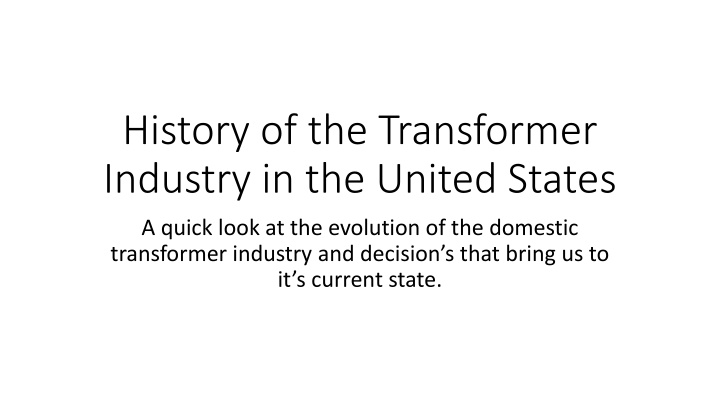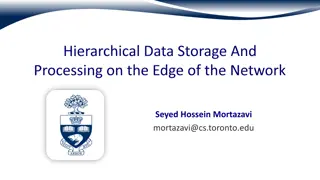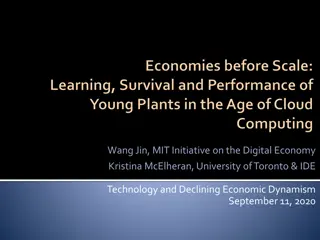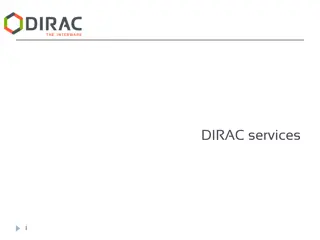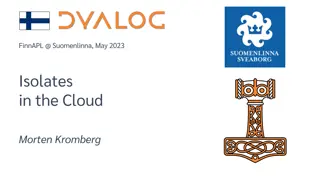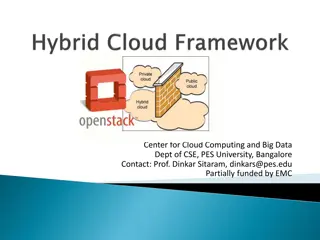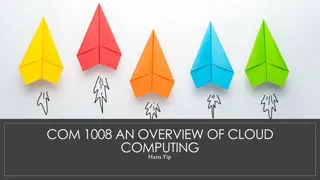Cloud Computing Overview & Evolution
Cloud computing involves moving computing services from desktop PCs/data centers to internet-based providers. It offers scalable and elastic services, charging users only for resources used. The evolution from traditional computing methods involves subscribing to services rather than owning and managing hardware and software. Various cloud service models and types of clouds exist, catering to different needs and preferences in the digital landscape.
Download Presentation

Please find below an Image/Link to download the presentation.
The content on the website is provided AS IS for your information and personal use only. It may not be sold, licensed, or shared on other websites without obtaining consent from the author.If you encounter any issues during the download, it is possible that the publisher has removed the file from their server.
You are allowed to download the files provided on this website for personal or commercial use, subject to the condition that they are used lawfully. All files are the property of their respective owners.
The content on the website is provided AS IS for your information and personal use only. It may not be sold, licensed, or shared on other websites without obtaining consent from the author.
E N D
Presentation Transcript
History of the Transformer Industry in the United States A quick look at the evolution of the domestic transformer industry and decision s that bring us to it s current state.
Understanding magnetic theory Carl Gauss Wilhelm Weber Hans Christian Oersted George Simon Ohm Michael Faraday James Clerk Maxwell Nikola Tesla
AC vs DC Edison s vision was to use DC to power things. Electricity at that time was very localized and lighting was a major driver for it s use. He envisioned 110 VDC as a source of electricity Tesla was a visionary, seeing that AC electricity could be used for a number of reasons such as powering motors. Envisioned distributing power over long distances, and figured out 3 phase power. Tesla eventually went to work for George Westinghouse and the rest is history AC required the need for transformers, especially for lower voltage point of use applications
3 Phase Power, Key to Efficient Power Distribution
Early Magnetic Technology to deal with input voltage variables, Ferroresonat Transformer
Ferroresonat Transformer Uses A Resonant Winding To Keep Transformer at Saturation level During Operation, maintains constant secondary V
Low Voltage Point of Use transformers for Consumer Applications. Class 2 for user interface controls Furnace controls where user has access to low voltage Chargers for battery operated devices Wall Warts
Audio Output Transformers, High impedence source to 4 or 8 ohm speaker
Invention of Transistor allowed higher frequency operation, higher power density, needed Ferrite type core for loss control. Also created market for US based Ferrite Manufacturers Ferroxcube Magnetics Inc. Ferrite Indiana General Stackpole
The first of 3 major events that changed the US based Transformer Manufacturing. In 1993 the United States, Canada, and Mexico approved the North American Free Trade Agreement. NAFTA
NAFTA and Mexico NAFTA allowed US based manufactures to set up facilities in the Maquiladora areas of Mexico, just across the border from major US cities. Transformer manufacturing is a labor intensive process. Manufacturers were allowed to ship raw materials into their Mexican partnered facilities, have the labor portion of the manufacturing done at an extremely low cost and ship the finished product back to the US without any additional Tariffs. The mid 90 s became a mad rush to the Maquiladora areas of Mexico (Tijuana, Mexicali, Nogales, Juarez, Reynosa) for direct investment or subcontract partnerships. US customers became aware of the cost differential and began to push their suppliers as well transformer manufacture suppliers started moving as well. High volume meant automation or Mexico sourced.
Second defining event In 1996 the US Government passed the Telecommunications Act to essentially deregulated the market, allowing multiple companies to compete against each other for technical services. Coincides with the start of the public s introduction to the internet. Local and National telephone companies were anxious to get into the business of providing internet services however the system was only set up for telephone use through local switching stations. AOL (America On Line) was one of the first to test the imbedded infrastructure of our telephone system.
Just Not Prepared Telephone switches were matched to meet the demands of a local area based on statistical usage. A community of 10,000 phones may only need 2000 switches to adequately meet the needs of the specific area. Young Glenn would sit on his phone modem and hog a line for hours at a whooping 20Kbytes. Phone companies moved quickly to install DSL style switches to sell more services to their customers
Over Built DSL telephone switches had EP 13 style transformers to help filter data vs voice. Most transformers were built in the US using highly automated production line as millions of transformers were needed. By the end of 2001 over 100 million switches had been manufactured however total sales to the consumer was stagnate at around 1 million. The companies had way over built so in March of 2002 the production of DSL devices came to an abrupt halt.
Effect on US based Transformer Manufacturing Prior to the crash of 2002 there were over 3000 captive and commercial transformer manufacturing facilities in US Add the effect of September 11, 2001 and after everything, less than 700 facilities making transformers in the US remained. Companies simply pulled the plug on their machines which sent a ripple effect to the suppliers as well.
Last Nail in the Coffin To add insult to injury, in 2001 China was formally given Most Favored Nation Trade Status by the United States Although it was enacted in the early 1990 s, the formality began a more clear strategy of both the transformer manufacturers and customer motivations to be in China. Opened the door for Chinese manufacturers to enter the US Market. Affected mostly small linear type transformers, high frequency ferrite transformers, and small SMD magnetic components. As with NAFTA earlier, transformer manufactures began to open facilities in China or developed secure partner relationships. Customers demanded cheaper product
Current Issues facing the Industry Consolidations with Transformer Manufacturers leave less options for people in the industry and the customers Consolidations with the Customer base leaves less options for the small manufacturer as additional quality certification demands, financial strength and less willing to take on new suppliers Current political situations are forcing a reset of manufacturing strategies throughout the world, chasing the cheapest labor source on both sides of the equation. This means requalification issues, retraining, and cultural issues. Fewer opportunities for young entrepreneurial startups. Aging ownership and engineering expertise.
Opportunities in the Transformer Industry Alternative Energy development. Newer and Faster switching technologies (GAN) require specialized products for support. Newer materials being developed such as Essex 260C wire insulation. Electrification of almost everything from door bells to automotive require power and more portability. Consolidations can be a positive. Innovation will always be a key to success.
